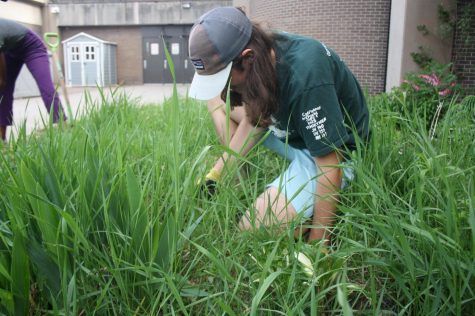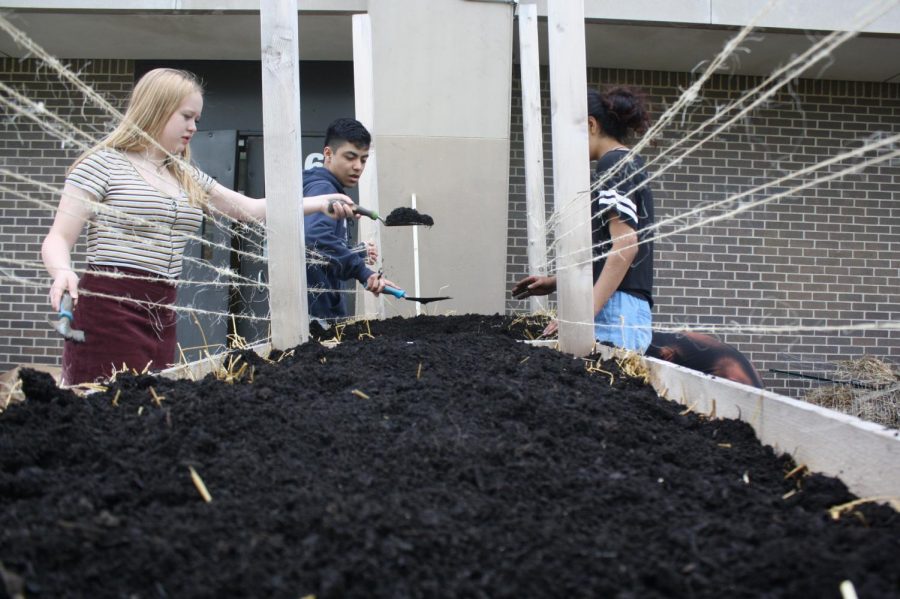Food justice is a movement centered in equality and intersectionality
Sophomores Zigi Kaiser-Holt and Emmanuel Najera Vilchis add dirt to a garden box during the South Garden Party. Overall, Science teacher Susan Peterson stated that one of the most important ways to contribute to food justice is “that people are educated around the impact of eating healthy foods and where there food comes from,” so that we as a society can shift towards an initiative for accessible, organic food for everybody.
Food justice is a movement which seeks to address the disparity in food accessibility through different communities. The movement is largely a response to the economic pressure on diverse families and communities as a whole which leads to limited access to diverse, healthy, culturally relevant, sustainably produced selections of food.
For many, food is not only important for nutrients, but is an element of culture and connectedness. Access to diverse, healthy food is something which the food justice movement wants to be seen as a fundamental right. Fresh produce shouldn’t only be a realistic expectation for higher class, privileged neighborhoods. The term “food desert” refers to an urban area in which it is difficult to buy healthy, high-quality, and affordable foods based on both products available and distance residents live from a grocery store.According to an article in the Star Tribune, Minnesota is ranked among the top ten food deserts in the country. This ranking becomes clear within North and South Minneapolis neighborhoods, especially areas which are densely Native people or people of color.
Jose Luis Villasenor is the founder of the organization Tamales y Bicicletas, a group which uses urban farming and sustainable transportation as a way to “decolonize our food system and bodies, to connect more with Mother Earth, and reduce our impact on the environment.”
Projects working to create equal accessibility to foods in the neighborhoods are very important to the overall well being of a community, as Environmental Science teacher Susan Peterson explained: “as the saying goes: ‘we all do better when we all do better,’ Paul Wellstone. Having access to healthy, nutritious food for everyone in Minneapolis supports health and well being of our citizens. This in turn allows people to engage in work, in school, and the daily activities that support our city.”
Villasenor explained the importance of intersectionality in the food justice conversation: “food justice should not exist [on its own]. Food justice is about workers rights, food justice is about cultural rights, Indigenous rights, food justice is about queer rights. My challenge within the food justice community is to look at how has food been used as a weapon, and how can we use food as an answer to oppression that we face everyday.”
To better understand how the need for a food justice movement was sparked, it is important to recognize both colonialism (the process in which political control is take over a country though the occupation of settlers and economic expulsion) and gentrification (the process of renovating or changing a community to appeal the the “middle-class taste”) as key factors, especially because “the effects of food deserts or lack of accessibility to healthy, nutritious food has a greater impact on communities of color,” as said by Peterson.
“One aspect that sometimes we forget about, but I think the biggest thing about food justice with [Tamales y Bicicletas] is that food is always being used as a weapon,” said Villasenor. An obvious example of this concept of “food as a weapon” is, as Villasenor explained, the harsh, labor-intensive working conditions many farmers face, partially among Latino workers.

Sophomore Lucas Nerbonne weeds during South’s annual Garden Party. “When we’re talking about food justice we’re talking about food security. If we localize our food systems, we’re not adding to the level of transporting a product or food that could increase climate change,” said Tamales y Bicicletas founder Jose Luis Villasenor.
Which crops are being most rampantly produced often is connected to what culture is “in control” of said place is, which we see change in situations of colonialism. Villasenor explained how the introduction of things like sugar, pork, and beef are not traditional for Indigenous communities near the Western hemisphere, the change in what is being produced around these groups came with European colonialism.
Organizations like Villasenor’s are working to reconnect people, food, and culture. “Using culture as a lens to reconnect with our food kind of gives us a better understanding that food is not just something you consume,” Villasenor expressed. “Food is medicine, food is a spiritual connection.”
“[Food] helps people to understand that [they] are important, [they] are a part of a culture.” One example Villasenor likes to go to is corn, a food which was initially just a weed, but is now a vitally important crop in society, thanks to Indigenous Meshika people beginning to harvest it. “Today, [corn] has changed the world,” Villasenor said.
To help add local perspective to this issue, Villasenor pointed out that “[Minneapolis has] a lot of people of color, low-income people, Indigenous folks, that live in areas that don’t have access to affordable, healthy food,” which makes it an “interesting place to have a conversation on food justice.”
In tackling the conversation of food justice, a wide variety of issues are encompassed. Food justice is not only about advocating for grocery stores across neighborhoods to have similarly health and diverse food, but is also about calling out the harmful ways food is made, and the reasons and ways in which people suffer. Food inequity is an intersectional issue, which involves environmental racism, classism and other inequities in society.
However, the fight for equal opportunities to have food is not just a matter of social justice, but also is about how healthy the food people can access is. According to Villasenor, he feels that a conversation on organic produce is often missed within the movement. Shopping organically is thought to be more healthy because of the lack of chemicals, more sustainable because of the means of production, and more ethical in terms of human treatment during production. “I know some people think like ‘oh organic is a class thing’ and that is for real, but it’s really important that we look at these things…[non-organic food] is harmful to [people] and their environment,” said Villasenor.
As a more unconventional approach to what the typical view of food justice is, Villasenor also considers his decision to be vegan a part of his personal approach to supporting food justice: “for me, veganism is a reclaiming of a non-colonial diet and that for me is the removal of milk, the removal of pork, and [consuming] domesticated animals,” as he had previously explained, food justice is largely about reconnecting people to their culture. For Villasenor, reconnecting to his culture means understanding and reclaiming the Mexican heritage that his parents teach him about.
Villasenor explained his veganism as being in a “first world” while “trying to connect with an indigenous diet,” or “reclaiming of a non-colonial diet.” He explained that if you look into the history domestication of animals in food production, it came with colonialism. “When the white folks came to Mexico, from my understanding, they came with these skills, this knowledge of ‘you domesticate animals and you drink pus from another animal’ the indigenous Mexicans were like ‘we don’t do that, if we’re going to eat meat, it’s ceremonial, it’s for a really important event that we’re going to hunt for, we’re going to do the work, not manipulate its existence.” Villasenor’s parents were both farmers in Mexico who grew and processed their own food.
An important and more discussed element of food justice is the concept of food accessibility, something which is often strived for through projects like urban farming and community gardens. Projects like these also help reach a more equitable food production system because, as Villasenor pointed out, “food justice is also talking about working conditions- so within the Latino community when we talk about food justice, we’re also talking about the conditions a lot of our community members work under… it’s hard labor work, little pay sometimes they have to use chemicals that are harmful to them and the environment, and the people that will consume those veggies.” When you cut back support for large scale farming industries, you also help to disenfranchise poor, discriminatory, and unsafe working conditions.
Environmental justice is also encompassed in this movement, largely because the consumption of locally grown produce cuts down both the packaging needed, and greenhouse gases emitted, in the process of getting the product safely to the consumers. “When we’re talking about food justice we’re talking about food security. If we localize our food systems, we’re not adding to the level of transporting a product or food that could increase climate change,” said Villasenor.
To help support the food justice movement, and ethical/sustainable food in general, Peterson recommended that people work towards supporting local businesses as well as “innovation in growing foods in unconventional ways- in warehouses, shipping container farms,” and any other urban farming type projects. Peterson considers herself an avid gardener, and also recommends trying out growing your own food.
When it comes to urban farming, Villasenor is an advocate for that initiative, but wants to make it clear that this can be a tricky subject. Because so much of the need for the food justice movement is on the effects of gentrification, he emphasized the importance of community involvement and leadership. “Urban farming is a great tool to promote food security, but we have to be careful that… folks that are directly affected by [food inequity] are driving the message or are driving the movement to develop urban farms,” he explained.
Overall, Peterson stated that one of the most important ways to contribute to food justice is “that people are educated around the impact of eating healthy foods and where there food comes from,” so that we as a society can shift towards an initiative for accessible, organic food for everybody.

Kinsley Wilcox McBride is a senior at South now in her fourth year of newspaper. She served as Features editor last year and is excited to be editor in...

Henry Holcomb is a senior at South and is the Features Editor for the Southerner. In his third year on the Southerner, Holcomb is excited to be involved...










